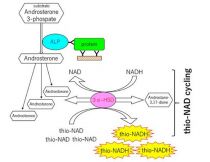Development of new diagnosis using ultrasensitive ELISA

- researcher's name
- affiliation
- keyword
-
background
● Generally, PCR is thought to be a definitive diagnosis, but it cannot discriminate between live and dead bacteria. It is also a question if target nucleic acids are transcribed into the proteins. Thus, an ideal diagnosis needs to detect proteins.
● At present, however, we do not have a method to detect a trace amount of protein accurately. Thus, we should develop a fast, easy and ultrasensitive method to detect a trace amount of protein for accurate diagnosis.
● At present, however, we do not have a method to detect a trace amount of protein accurately. Thus, we should develop a fast, easy and ultrasensitive method to detect a trace amount of protein for accurate diagnosis.
summary
● For this purpose, we have developed a de novo method using a sandwich ELISA combined with thio-NAD cycling.
predominance
● A trace amount of protein at 10-20 moles/assay can be detected in our ultrasensitive ELISA combined with thio-NAD cycling. It can be achieved with tens of minutes. This sensitivity is 1000-fold more sensitive than conventional methods.
application/development
● Our present method is versatile, when we have specific antibodies against the target proteins.
● Our method is used not only for diagnoses of infectious diseases, but also for measurements of cancer markers.
● Our method can be used in the field of food industry.
● 【Examples of detection】Infection:HIV-1 p24,M. tuberculosis
● 【Examples of detection】Lifestyle diseases:Adiponectin,Insulin
● Our method is used not only for diagnoses of infectious diseases, but also for measurements of cancer markers.
● Our method can be used in the field of food industry.
● 【Examples of detection】Infection:HIV-1 p24,M. tuberculosis
● 【Examples of detection】Lifestyle diseases:Adiponectin,Insulin
same researcher's seeds
posted:
2019/10/21





